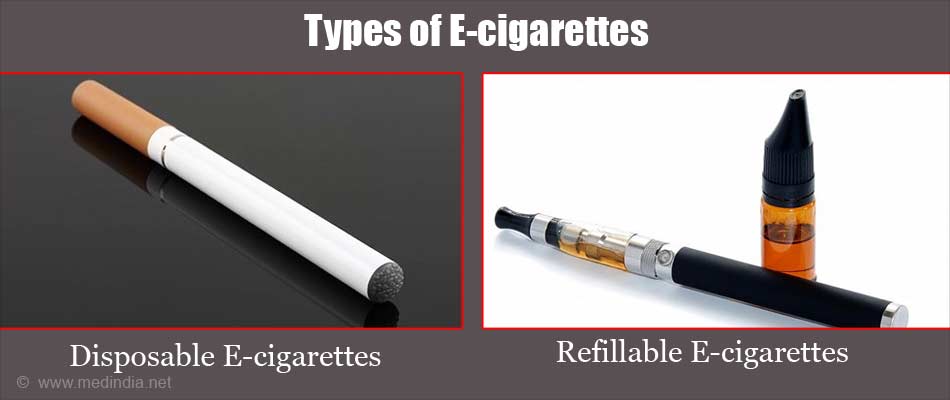- E-cigarettes: an evidence update: A report commissioned by Public Health England
- Journal of Epidemiology & Community Health: Chemical evaluation of electronic cigarettes
- Safety evaluation and risk assessment of electronic cigarettes as tobacco cigarette substitutes: a systematic review - (https://www.ncbi.nlm.nih.gov/pmc/articles/pmc4110871/)
What are E-cigarettes?
E-cigarettes, are electronic cigarettes that are classified among the Electronic Nicotine delivery devices. They are often battery operated, containing nicotine with flavors and other chemicals in the form of vapor instead of smoke. E-cigarettes are available in the shape of a pen or a cigarette, although refillable ones look slightly different. Other nicotine delivery devices include vaporizers, hookah pens, vape pens, electronic cigars and electronic pipes, among others.
Types of E-cigarettes
E-cigarettes can be categorized into 3 types:
Disposable E-cigarettes: These look like normal cigarettes and have a glowing end due to a Light Emitting Diode (LED). The device can be recharged on requirement and it has a replaceable cartridge. These cigarettes have a short battery life, hence run out fast and the vapor performance is also poor.
Refillable E-cigarettes: It is one of the better electronic cigarettes which can be refilled and they provide a longer battery life, hence a better vapor performance.
Advanced E-cigarettes: These devices are aimed at achieving maximum vapor performance from the device.

How do E-cigarettes Work?
Most e-cigarettes consist of 3 main components:
- Cartridge: This holds the liquid solution containing nicotine and other flavors or chemicals. The liquid nicotine is obtained by extracting it from tobacco and mixing it with a base like propylene glycol.
- Vaporizer: The device heats the liquid to 55°, at this temperature the liquid turns into vapor that is inhaled.
- Power Supply: The battery powers up the device, puffing helps in activating this device.
What Chemicals are Used in E-cigarettes?
E-cigarettes are taken as a healthier alternative among ex-smokers, it is also taken as a safer way to inhale nicotine. The major chemical in e-cigarettes is nicotine, while solvents used are:
- Aldehydes like Formaldehyde, Acrolein, Acetaldehyde, Acetone, Methyl benzaldehyde
- Nitrosamines
- Metals like nickel, chromium, lead
- Polycyclic aromatic hydrocarbons
- Tobacco alkaloids
- Volatile organic compounds
- Flavors
- Solvent carriers
Nicotine is the main ingredient of e-cigarettes and it is an addictive agent. The content of nicotine often varies by brand and the type of e-cigarettes. Studies reveal that the nicotine delivery from 300 puffs range from 2 to 15 mg. This is not related to the content of the nicotine in the liquid. The level of nicotine in the vapor is also found to be much lesser than the conventional cigarettes.

The other chemicals that are seen in the vapor are produced during the oxidation of the humectants used in the e cigarettes. These chemicals are potentially harmful. The levels of these chemicals vary with each model. These chemicals are also seen in conventional cigarettes and studies have been conducted to identify the risk they pose as many are toxic and carcinogenic chemicals.
Are E-cigarettes Safer than Conventional Cigarettes?
An e-cigarette is found to be less harmful, as compared to conventional cigarettes. The lack of combustion reduces many harmful chemicals present in the conventional cigarette smoke. The toxic chemicals that are also seen in e-cigarettes are at a much lower concentration than in the former.
E–cigarettes should be used only as an alternative for regular smokers and those who have a relapse due to the nicotine addiction. But this device should not be used by youngsters as risks do exist in its use.
How Do E-cigarettes Help a Person to Reduce Tobacco Smoking?
E-cigarettes, used as an alternative among smokers help in reducing their exposure to harmful chemicals. Further improvements in the electronic device can help in reducing the emission of harmful chemicals. It helps in reducing the devastating effects of tobacco smoking.
What are the Adverse Effects Associated with the Use of E-cigarettes?
Few adverse events have been reported with the use of e-cigarettes. As the main content of the device is nicotine, there may be accidental exposure of liquid nicotine in high doses by ingestion or skin contact to the person or to a child if left unattended. The first symptoms of such a poisoning would be excessive vomiting.
Burns have been reported due to battery explosion, sparked off by faulty devices. Other adverse events reported in foreign studies include pneumonia, seizure, heart failure and hypotension.












